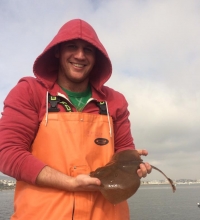
PRINCIPAL INVESTIGATORS: Chris Lowe, California State University Long Beach
CO-PRINCIPAL INVESTIGATORS: Varenka Lorenzi (California State University Long Beach), Ryan Freedman (NOAA Channel Islands NMS), Kady Lyons (Georgia Aquarium)
PROJECT ADMINISTRATORS: California Sea Grant
PROJECT SUMMARY:
Recent discoveries of deep-water DDT+ contamination continue to put Southern California communities at risk since these contaminants accumulate through the food web, which may eventually pose a human health concern if contaminated seafood enters the food supply. Previous research has focused on detecting DDT in fish species with high market value such as the white croaker. However, comparatively less information exists about lower market value commercial species or subsistence fishing targets, such as smaller sharks and rays (broadly called elasmobranchs), despite the fact many of these species spend significant time near DDT+ contaminated sediments and are increasingly an important source of protein for low-income communities in Southern California.
This project will collect tissue samples of angel sharks, bat rays and leopard sharks in southern California and analyze them for DDT+ as well as other commonly accumulated contaminants. The researchers will also use satellite and acoustic tags to track the animals’ movements and understand where they could be exposed to DDT. This will provide the most comprehensive account to-date of the level and spatial extent of contamination in multiple species of sharks and rays in southern California and will help to better understand the relative risk these species pose to introducing contaminants to important marine management areas and to the people who rely on them for nutrition. This information is urgently needed to ensure that vulnerable communities have access to affordable, clean and safe sources of protein.
Results regarding elasmobranch DDT+ contamination will be shared with local fishers through the Heal the Bay Angler Outreach Program as well as with the Office of Environmental Health Hazard Assessment, which sets fish consumption guidelines, the United States Environmental Protection Agency, and the California Department of Fish and Wildlife.
DETAILED RESEARCH OBJECTIVES:
- Quantify the POP contaminant load and signatures in tissues (i.e., white muscle and liver) of Angel Sharks, Bat Rays, and Leopard Sharks collected in southern California through partnerships with fishers, local seafood markets, and during dedicated research trips to infer potential sources of DDT exposure and accumulation. Animals will be sampled in the field from known areas of contaminants (Los Angeles County) and less exposed areas (Channel Islands and Santa Barbara County) to quantify and compare POP concentrations across body sizes and contaminant exposure areas. Tissue samples will then be analyzed for for 2,4-DDT and 4,4-DDT and their metabolites (2,4-DDE; 4,4-DDE; 2,4-DDD; 4,4-DDD; 4,4-DDMU), chlordanes (oxychlordane, gamma-, alpha-, trans-,cis-chlordane), and 54 congeners of PCBs.
- Delineate the spatial distribution of Angel Sharks, Bat Rays, and Leopard Sharks using satellite and acoustic tags to understand habitat use (e.g., space use, depth) and quantify the degree of overlap with known DDT-contaminated sites to determine where these species may be exposed to POP contaminants and where they may translocate POP loads. Stable isotope analysis of muscle, liver and blood will be used to determine trophic level and estimate foraging depth of each species.
- Define each species’ biovector potential to act as contaminant transporters to human communities. Contaminant load, movements near areas of known contaminant exposure (i.e. harbors, Superfund site, newly discovered DDT dumpsite) as well as proximity to piers where local fishing takes place, and trophic level data will be used to generate models to understand translocation of contaminants and estimate degree of exposure to subsistence fishers.
- Evaluate the contaminant exposure risk from consumption of Angel Shark, Bat Ray, and Leopard Shark to at-risk or low-income populations in Los Angeles, Ventura and Santa Barbara Counties from fishers surveys conducted by partners at Heal The Bay.

Soxhlet extraction is the first step for extraction of organic contaminants from fish tissues. Specific solvents are used that allow contaminants to move from the tissues to the extract, which will be further purified before analysis.
 Ryan Freedman
Ryan Freedman